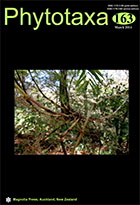Abstract
Recent taxonomic revisions within the cyanobacteria have shown that the traditional simple filamentous genera often represent large polyphyletic clusters of not-so-closely-related taxa. In this study, the new cyanobacterial genus Kastovskya is described based on a combination of morphological, molecular, and ecological evidence. Kastovskya was first described as Schizothrix adunca, a morphospecies discovered in the Atacama Desert, Chile more than 50 years ago. This species has been transferred to Kastovskya and serves as the generitype. Kastovskya adunca currently represents a unique and probably endemic taxon for the soils of the Atacama Desert region. Description of this new genus contributes to the revision of the Phormidiaceae by providing a clear taxonomic definition to one of the clades within the Schizothrix/Microcoleus/Phormidium cluster.

